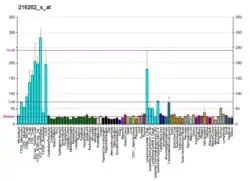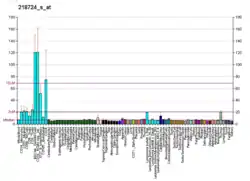TGIF2
Homeobox protein TGIF2 is a protein that in humans is encoded by the TGIF2 gene.[5][6]
The protein encoded by this gene is a DNA-binding homeobox protein and a transcriptional repressor. The encoded protein appears to repress transcription by recruiting histone deacetylases to TGF beta-responsive genes. This gene is amplified and overexpressed in some ovarian cancers, and mutations in this gene can cause holoprosencephaly.[6]
References
- GRCh38: Ensembl release 89: ENSG00000118707 - Ensembl, May 2017
- GRCm38: Ensembl release 89: ENSMUSG00000062175 - Ensembl, May 2017
- "Human PubMed Reference:". National Center for Biotechnology Information, U.S. National Library of Medicine.
- "Mouse PubMed Reference:". National Center for Biotechnology Information, U.S. National Library of Medicine.
- Imoto I, Pimkhaokham A, Watanabe T, Saito-Ohara F, Soeda E, Inazawa J (Oct 2000). "Amplification and overexpression of TGIF2, a novel homeobox gene of the TALE superclass, in ovarian cancer cell lines". Biochem Biophys Res Commun. 276 (1): 264–70. doi:10.1006/bbrc.2000.3449. PMID 11006116.
- "Entrez Gene: TGIF2 TGFB-induced factor homeobox 2".
Further reading
- Andersson B, Wentland MA, Ricafrente JY, et al. (1996). "A "double adaptor" method for improved shotgun library construction". Anal. Biochem. 236 (1): 107–13. doi:10.1006/abio.1996.0138. PMID 8619474.
- Yu W, Andersson B, Worley KC, et al. (1997). "Large-Scale Concatenation cDNA Sequencing". Genome Res. 7 (4): 353–8. doi:10.1101/gr.7.4.353. PMC 139146. PMID 9110174.
- Melhuish TA, Gallo CM, Wotton D (2001). "TGIF2 interacts with histone deacetylase 1 and represses transcription". J. Biol. Chem. 276 (34): 32109–14. doi:10.1074/jbc.M103377200. PMID 11427533.
- Deloukas P, Matthews LH, Ashurst J, et al. (2002). "The DNA sequence and comparative analysis of human chromosome 20". Nature. 414 (6866): 865–71. doi:10.1038/414865a. PMID 11780052.
- Watanabe T, Imoto I, Katahira T, et al. (2003). "Differentially regulated genes as putative targets of amplifications at 20q in ovarian cancers". Jpn. J. Cancer Res. 93 (10): 1114–22. doi:10.1111/j.1349-7006.2002.tb01213.x. PMC 5926887. PMID 12417041.
- Strausberg RL, Feingold EA, Grouse LH, et al. (2003). "Generation and initial analysis of more than 15,000 full-length human and mouse cDNA sequences". Proc. Natl. Acad. Sci. U.S.A. 99 (26): 16899–903. doi:10.1073/pnas.242603899. PMC 139241. PMID 12477932.
- Ota T, Suzuki Y, Nishikawa T, et al. (2004). "Complete sequencing and characterization of 21,243 full-length human cDNAs". Nat. Genet. 36 (1): 40–5. doi:10.1038/ng1285. PMID 14702039.
- Gerhard DS, Wagner L, Feingold EA, et al. (2004). "The Status, Quality, and Expansion of the NIH Full-Length cDNA Project: The Mammalian Gene Collection (MGC)". Genome Res. 14 (10B): 2121–7. doi:10.1101/gr.2596504. PMC 528928. PMID 15489334.
- Kimura K, Wakamatsu A, Suzuki Y, et al. (2006). "Diversification of transcriptional modulation: Large-scale identification and characterization of putative alternative promoters of human genes". Genome Res. 16 (1): 55–65. doi:10.1101/gr.4039406. PMC 1356129. PMID 16344560.
This article is issued from Wikipedia. The text is licensed under Creative Commons - Attribution - Sharealike. Additional terms may apply for the media files.





